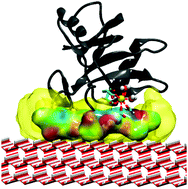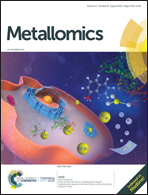Calcium ion implicitly modulates the adsorption ability of ion-dependent type II antifreeze proteins on an ice/water interface: a structural insight†
Abstract
Ion dependent type II antifreeze proteins (AFPs) are an unusual design of natural evolution for cold-acclimatization of fishes in the Antarctic region. This class of proteins requires Ca2+ to perform an unusual biological recognition, binding to a specific ice plane. However, an ice–protein complex is yet to be characterized at the molecular scale. Here, using equilibrium simulations, free energy calculations and metadynamics, we have elucidated this unusual ice recognition phenomenon at the atomistic level. The origin of ion selectivity has been critically investigated to identify the role of different ions in the dynamics and ice binding ability of the protein. We have demonstrated that within the type II protein matrix, the preferred coordination number of Ca2+ is seven involving five protein atoms and two water molecules. Due to this coordination geometry, the ion binding loop adopts a flat solvent exposed conformation which helps the AFP to efficiently adsorb on the prism plane. The ice binding surface (IBS) adsorbs on the ice surface mediated by a layer of ordered water. Structural synergy between the ice/water interface of the prism plane and the water structure around the IBS makes the adsorption highly favorable. On the other hand, the preferred geometry of the Zn2+ coordination sphere within the AFP matrix is tetrahedral. Both the coordination number and the coordination bond length are smaller for Zn2+ in comparison to Ca2+. Thus to optimize the coordination sphere for Zn2+ within the protein matrix, a kink is introduced in the ion binding loop, a part of the IBS. Therefore, the IBS and ice surface complementarity is greatly perturbed which leads to less effective adsorption.



 Please wait while we load your content...
Please wait while we load your content...